NVIDIA GeForce GTX 780 Review: The New High End
by Ryan Smith on May 23, 2013 9:00 AM ESTCompute
Jumping into compute, we should see a mix of results here, with some tests favoring the GK110 based GTX 780’s more compute capable design, while other tests will punish it for not being a fast FP64 card like GTX Titan.
As always we'll start with our DirectCompute game example, Civilization V, which uses DirectCompute to decompress textures on the fly. Civ V includes a sub-benchmark that exclusively tests the speed of their texture decompression algorithm by repeatedly decompressing the textures required for one of the game’s leader scenes. While DirectCompute is used in many games, this is one of the only games with a benchmark that can isolate the use of DirectCompute and its resulting performance.
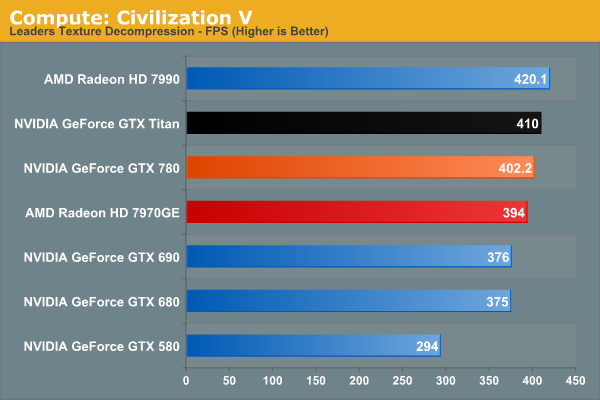
Civilization V’s DirectCompute performance is looking increasingly maxed out at the high end. At 402fps the GTX 780 may as well be tied with GTX Titan. On the other hand it’s a reminder that while we don’t always see NVIDIA do well in our more pure compute tests, it can deliver where it matters for games with DirectCompute.
Our next benchmark is LuxMark2.0, the official benchmark of SmallLuxGPU 2.0. SmallLuxGPU is an OpenCL accelerated ray tracer that is part of the larger LuxRender suite. Ray tracing has become a stronghold for GPUs in recent years as ray tracing maps well to GPU pipelines, allowing artists to render scenes much more quickly than with CPUs alone.
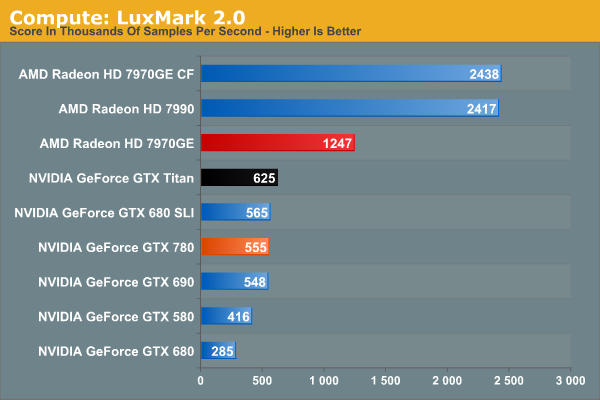
NVIDIA has never done well at LuxMark, and GTX 780 won’t change that. It’s greatly faster than GTX 680 and that’s about it. Kepler parts, including GK110, continue to have trouble with our OpenCL benchmarks, as evidenced by the fact that GTX 780 doesn’t beat GTX 580 by nearly as much as the generational improvements should lead to. GK110 is a strong compute GPU, but not in ways that LuxMark is going to benefit.
Our 3rd benchmark set comes from CLBenchmark 1.1. CLBenchmark contains a number of subtests; we’re focusing on the most practical of them, the computer vision test and the fluid simulation test. The former being a useful proxy for computer imaging tasks where systems are required to parse images and identify features (e.g. humans), while fluid simulations are common in professional graphics work and games alike.
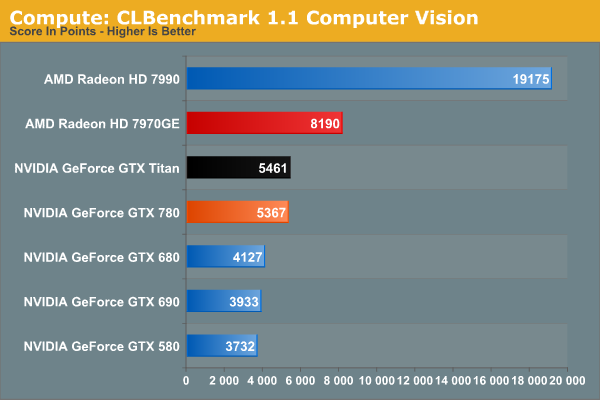
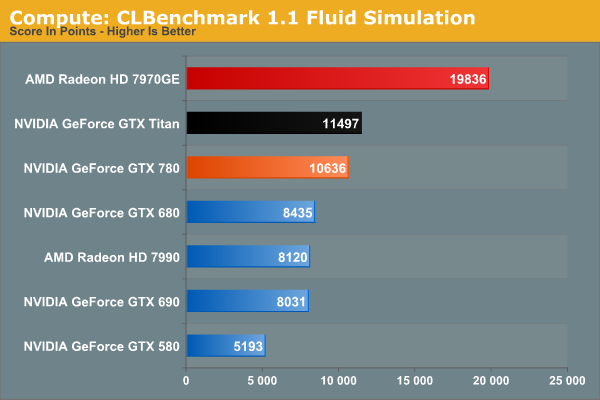
GTX 780 still struggles some at compute with CLBenchmark, but less so than with LuxMark. 7970GE is the clear winner here in both tests, while GTX 780 stays remarkably close to GTX Titan in performance. The fluid simulation in particular makes GTX 780 look good on a generational basis, more than doubling GTX 580’s performance.
Moving on, our 4th compute benchmark is FAHBench, the official Folding @ Home benchmark. Folding @ Home is the popular Stanford-backed research and distributed computing initiative that has work distributed to millions of volunteer computers over the internet, each of which is responsible for a tiny slice of a protein folding simulation. FAHBench can test both single precision and double precision floating point performance, with single precision being the most useful metric for most consumer cards due to their low double precision performance. Each precision has two modes, explicit and implicit, the difference being whether water atoms are included in the simulation, which adds quite a bit of work and overhead. This is another OpenCL test, as Folding @ Home has moved exclusively to OpenCL this year with FAHCore 17.

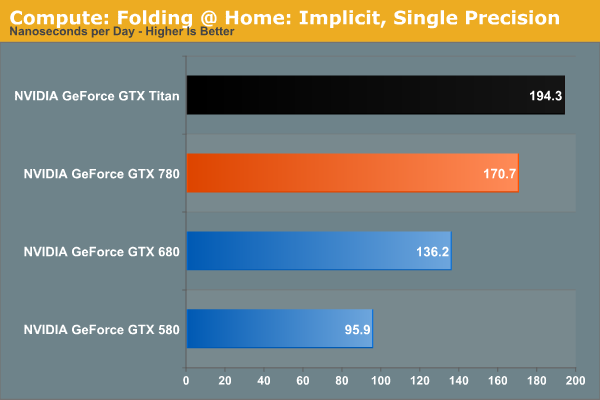
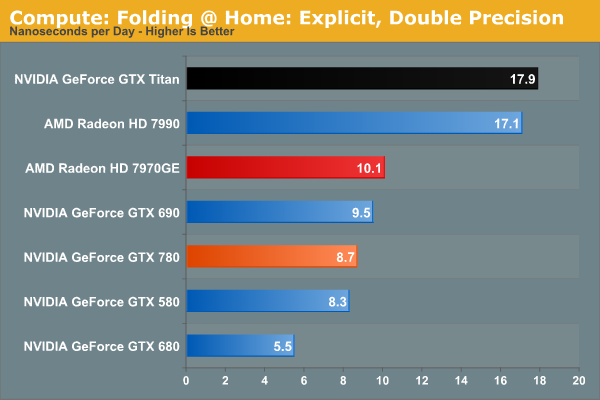
The Folding@Home group recently pushed out a major core update(FAHBench 1.2.0), which we’ve rerun on a number of cards and is reflected in our results. Unfortunately this version also broke single precision implicit on AMD GPUs and AMD’s latest drivers, so we only have NVIDIA GPUs for that section.
In any case, despite the fact that this is an OpenCL benchmark this is one of the cases where NVIDIA GPUs do well enough for themselves in single precision mode, with GTX 780 surpassing 7970GE, and falling behind only GTX Titan and the 7990. GTX 780 doesn’t necessarily benefit from GK110’s extra compute functionality, but it does see a performance improvement over GTX 680 that’s close to the theoretical difference in shader performance. Meanwhile in double precision mode, the lack of an uncapped double precision mode for GTX 780 means that it brings up the bottom of the charts compared to Titan and its 1/3 FP64 rate. Compute customers looking for a bargain NVIDIA card (relatively speaking) will need to stick with Titan.
Wrapping things up, our final compute benchmark is an in-house project developed by our very own Dr. Ian Cutress. SystemCompute is our first C++ AMP benchmark, utilizing Microsoft’s simple C++ extensions to allow the easy use of GPU computing in C++ programs. SystemCompute in turn is a collection of benchmarks for several different fundamental compute algorithms, as described in this previous article, with the final score represented in points. DirectCompute is the compute backend for C++ AMP on Windows, so this forms our other DirectCompute test.
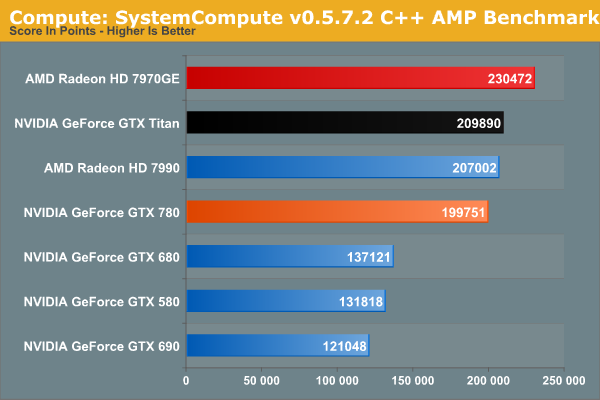
SystemCompute shows very clear gains over both the GTX 680 and GTX 580, while trailing the GTX Titan as expected. However like Titan, both trail the 7970GE.










155 Comments
View All Comments
Akrovah - Friday, May 24, 2013 - link
Oh yeah, forgot audio data, all of which gets stored in main RAM. And THAT will take up a pretty nice chunk of space righ there.Sivar - Thursday, May 23, 2013 - link
You realize, of course, that the 8GB RAM in consoles is 8GB *TOTAL* RAM, whose capacity and bandwidth must be shared for video tasks, the OS, and shuffling the game's data files.A PC with a 3GB video card can use that 3GB exclusively for textures and other video card stuff.
B3an - Friday, May 24, 2013 - link
See my comment above.DanNeely - Thursday, May 23, 2013 - link
Right now all we've got is the reference card being rebadged by a half dozenish companies. Give it a few weeks or a month and I'm certain someone will start selling a 6GB model. People gaming at 2560 or on 3 monitor setups might benefit from the wait; people who just want to crank AA at 1080p or even just be able to always play at max instead of fiddling with settings (and there're a lot more of them than there are of us) have no real reason to wait. Also, in 12 months Maxwell will be out and with the power of a die shrink behind it the 860 will probably be able to match what the 780 does anyway.DanNeely - Tuesday, May 28, 2013 - link
On HardOCP's forum I've read that nVidia's told it's partners they shouldn't make a 6GB variant of the 780 (presumably to protect Titan sales). While it's possible one of them might do so anyway; getting nVidia mad at them isn't a good business strategy so it's doubtful any will.tipoo - Thursday, May 23, 2013 - link
If a slightly cut down Titan is their solution for the higher end 700 series card, I wonder what else the series will be like? Will everything just plop down a price category, the 680 in the 670s price point, etc? That would be uninteresting, but reasonable I guess, given how much power Kepler has on tap. And it wouldn't do much for mobile.DigitalFreak - Thursday, May 23, 2013 - link
The 770 will be identical to the 680, but with a slightly faster clock speed. I believe the same will be true with the 760 / 670. Those cards are probably still under NDA, which is why they weren't mentioned.chizow - Thursday, May 23, 2013 - link
Yep 770 at least is supposed to launch a week from today, 5/30. Satisfy demand from the top-down and grab a few impulse buyers who can't wait along the way.yannigr - Thursday, May 23, 2013 - link
No free games. With an AMD card you also get many AAA games. So Nvidia is a little more expensive than just +$200 compared with 7970GE.I am expecting reviewers someday to stop ignoring game bundles because they come from AMD. We are not talking for one or two games here, for old games, or demos. We are talking about MONEY. 6-7-8-9-10 free AAA titles are MONEY.
Tuvok86 - Thursday, May 23, 2013 - link
I believe nVidia has bundles as well